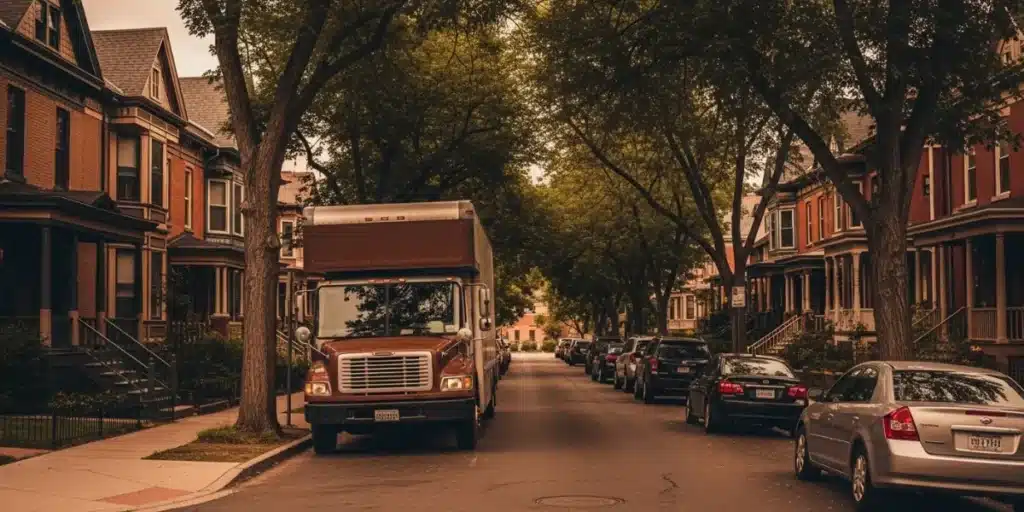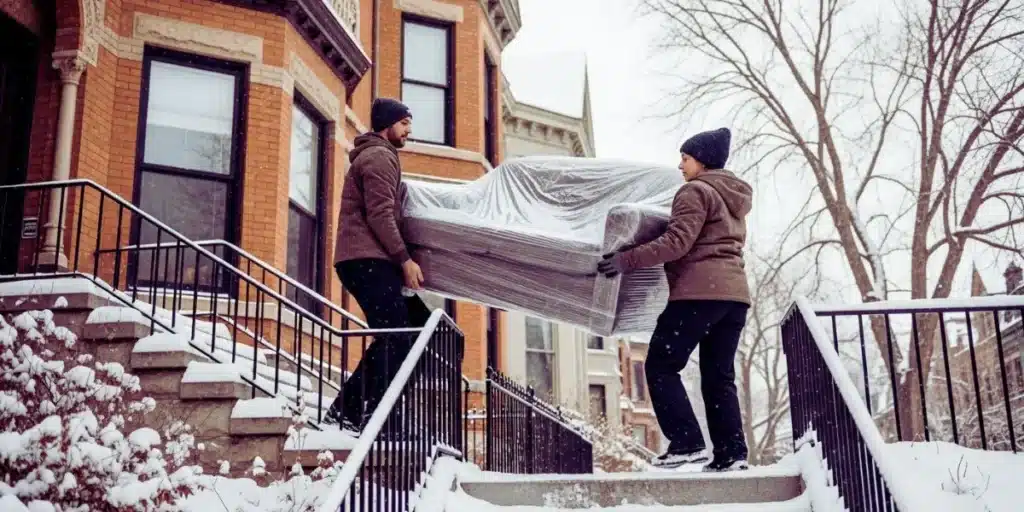Last month, we quoted two identical 3-bedroom moves on the same day – one to Montbello, another to Highlands: same truck, same crew size, same amount of stuff. The difference in complexity and moving costs was remarkable. After moving thousands of Denver families, we’ve learned that where you’re moving within the city matters as much as what you’re driving.
Most moving companies won’t tell you this upfront because they don’t want to complicate their sales process. But we’ve seen too many families get blindsided by “surprise” charges that could have been avoided with honest communication. Here’s what we wish every Denver homebuyer knew before they signed their lease or purchase agreement.
The Hidden Neighborhood Premium Nobody Talks About
Sarah thought she was getting a great deal when she found a house in Montbello. “It’s so much more affordable than Park Hill,” she told us during her consultation. What she didn’t realize was that every Denver neighborhood has its own moving personality – some straightforward, others requiring specialized approaches.
The house was perfect – a well-maintained ranch with an attached garage, ideal for her growing family. Montbello’s wide suburban streets and newer construction made for a very efficient move. But the experience taught us that families often don’t realize how much neighborhood infrastructure affects their moving day experience.
What surprised Sarah:
- Moving day went smoother than expected due to the wide streets
- Suburban layout made truck positioning straightforward
- Overall, the experience was more efficient than her previous Capitol Hill move
This experience taught us that assumptions about the complexity of neighborhood moves don’t always match reality.
But that was nothing compared to what we discovered about Denver’s most desirable close-in neighborhoods, where proximity to downtown creates entirely different complications.
The real sticker shock comes when you move to Denver’s most desirable areas, where proximity to downtown creates entirely different complications.

When “Close to Downtown” Becomes a Moving Challenge
Tom and Jennifer were thrilled about their Victorian in Park Hill. “We can bike to work downtown,” Jennifer said. “And look at these gorgeous tree-lined streets!”
Those same tree-lined streets that attracted them became our biggest challenge. Mature elm trees created a 12-foot canopy over narrow streets designed in 1910, long before anyone imagined 26-foot moving trucks. Our standard equipment wouldn’t fit.
The Park Hill reality check:
- Required a smaller truck due to narrow, tree-lined streets
- Multiple trips instead of one efficient load
- Specialized equipment for narrow access
- Historic Victorian doorways required furniture disassembly
- Tree-lined street parking took extra coordination time
Tom and Jennifer’s “convenient” location added significant complexity and time to their move.
This is why we now do pre-move consultations for any home built before 1950. It’s not about making moves more expensive – it’s about preventing the frustration of moving day surprises that turn a 6-hour move into a 10-hour ordeal.
The Lowry Success Story
We once moved a family who outgrew a Capitol Hill apartment to a 2,400-square-foot townhome in Lowry. The customer was worried about moving costs after hearing horror stories from friends about Denver neighborhood complications.
Lowry surprised us both. The former Air Force base conversion created something unique in Denver – wide streets designed for large vehicles, planned infrastructure, and consistent building codes throughout the community.
The Lowry advantage:
- Wide streets accommodate full-size moving trucks
- Planned community design with logical layouts
- Modern construction standards throughout
- Ample parking for crew vehicles
- No historic building complications
What started as a potentially complex move became one of our most efficient. The planned infrastructure meant smooth truck access, standard doorways, and predictable logistics. The customer’s final time came in well under our estimate.
The lesson? Sometimes the “premium” neighborhood makes your move faster and more efficient.
The Stapleton Experience That Changed Our Approach
Central Park (formerly Stapleton) taught us an important lesson about neighborhood expectations. When we first started getting calls from the new development in 2005, we approached it like any other suburban community.
Then we realized this wasn’t just about logistics – it was about understanding what different communities value. Central Park families often prioritized detailed planning, clear communication, and professional presentation that matched their investment in the community.
The Central Park learning curve:
- Customers appreciated detailed pre-move consultations
- Premium homes benefited from extra protection materials
- The professional community meant professional service expectations
- Clear communication throughout the process was highly valued
This experience taught us that successful moving isn’t just about getting belongings from point A to point B – it’s about understanding what each community values and delivering accordingly.
What Real Estate Agents Don’t Tell You About Moving Costs
Here’s something most real estate agents don’t know: certain neighborhoods consistently generate more moving complications (and costs) than others. We track this data because it helps us give accurate estimates, but homebuyers rarely get this information during their house search.
Neighborhoods that consistently run overestimate:
- Capitol Hill: Historic buildings, narrow access, parking challenges
- Highlands/Berkeley: Narrow streets, mature trees, Victorian architecture
- Washington Park area: Tree-canopied streets, historic home complications
- Park Hill: Victorian-era complications, gentrification creating mixed expectations
These neighborhoods usually come in under the estimate:
- Montbello: Wide suburban streets, newer construction, straightforward access
- Lowry: Planned infrastructure, wide streets designed for modern traffic
- Stapleton/Central Park: Modern planned community, efficient logistics
- Glendale: Compact area with good access (though technically a separate city within Denver metro)
Neighborhoods with the most variables:
- LoDo: High-rise complexity varies dramatically by building
- RiNo: Rapid development means constant infrastructure changes
- Five Points: Mix of historic and new construction creates unpredictable challenges
We started sharing this data with some of our real estate agent partners, and they’ve found their clients appreciate the transparency. Nobody likes financial surprises, especially during the already expensive home-buying process.

The Season That Changed Everything
March 2019 taught us never to underestimate Denver weather’s impact on moving costs. We had 47 moves scheduled that month – then the second-biggest blizzard in Denver history hit on March 13th.
Interstate highways shut down for three days. Side streets in neighborhoods like Park Hill and Capitol Hill remained unplowed for a week. We had customers stranded in temporary housing, belongings in our warehouse, and a scheduling nightmare that took six weeks to resolve.
The lessons from the March 2019 blizzard:
- Weather delays aren’t just inconvenient – they’re expensive
- Some neighborhoods get plowed faster than others (main arteries first)
- Moving season isn’t just about demand – it’s about weather vulnerability
- Having a local moving company with warehouse space matters during extended delays
Now we track weather patterns like a meteorology service. March is statistically Denver’s snowiest month, but sudden storms can hit from October through May. We factor weather risk into our scheduling and pricing, especially for neighborhoods with historically slower snow removal.
The Real Cost of “Cheap” Moving Estimates
Here’s the uncomfortable truth: if a moving company’s estimate seems too good to be true for your neighborhood, it probably is. We compete with companies that quote artificially low prices, then hit customers with “surprise” charges on moving day.
Common hidden complexity tactics we’ve seen:
- Long walk charges (not disclosed until moving day)
- Stair charges (even for single-story homes with front steps)
- Assembly/disassembly fees (not mentioned in initial quote)
- Marked-up packing materials (charged at premium rates)
- Travel time charges (despite knowing the distance during the estimate)
Last year, we had a customer who went with a competitor’s significantly lower quote for a move to Montbello. Three hours into moving day, she called us in tears. The “cheap” movers were demanding substantial additional fees for charges that weren’t disclosed upfront. Her “bargain” quote had become more expensive than our transparent estimate.
We picked up the move, finished it professionally, and charged exactly what we quoted. She became one of our best reviewers and has referred four friends since then.
How We Approach Denver Neighborhood Moves
Since transparency matters to us, here’s exactly how we think about quotes for different Denver neighborhoods:
Base considerations:
- Home size and estimated volume
- Number of crew members required
- Estimated time based on 20+ years of local experience
Neighborhood-specific factors:
- Distance from our headquarters (travel time considerations)
- Access challenges (narrow streets, stairs, elevators)
- Permit requirements (downtown, historic districts)
- Seasonal considerations (winter weather risk, peak demand)
Service level requirements:
- Standard service (most residential neighborhoods)
- Enhanced service (areas with unique challenges)
- Specialty service (antiques, pianos, art collections)
We built our reputation on accurate estimates, not low-ball quotes. Our estimates typically reflect the real variables that affect your specific move, which means fewer surprises and more predictable experiences.
What Denver’s Neighborhoods Teach Us About Moving
After 20 years of moving Denver families, we’ve learned that each neighborhood has its character, and that character affects your moving costs and experience in ways most people don’t expect.
Neighborhoods where moves tend to be straightforward:
Lowry: Former Air Force base with wide streets and planned infrastructure. Modern construction standards mean fewer surprises and predictable logistics. Military planning created excellent vehicle access throughout the community.
Stapleton/Central Park: Planned community design makes moves efficient and predictable. Wide streets, consistent building codes, and thoughtful layouts support smooth relocations.
Montbello: Wide suburban streets and newer construction (1960s-2000s) create efficient moving conditions. Good vehicle access and standard building features throughout most of the area.
Neighborhoods that require specialized expertise:
Capitol Hill: Historic character means historic challenges. Victorian-era buildings, narrow streets, and unique architectural features require experienced crews who understand older construction.
Park Hill: Beautiful historic homes with period features that need careful handling. The area’s ongoing revitalization means a mix of restoration projects and move-in-ready homes.
Highlands/Berkeley: Trendy neighborhoods with narrow streets and mature landscaping. Popular areas with limited parking and truck access considerations.
What We Wish Every Denver Family Knew
Moving costs and complexity isn’t just about distance or house size. It’s about the intersection of infrastructure, weather, timing, and service expectations that make each Denver neighborhood unique.
The most complex move isn’t always the luxury neighborhood. Sometimes it’s the charming historic district with narrow streets and Victorian architecture.
The lowest estimate isn’t always the best value. Companies that don’t understand Denver’s neighborhood challenges often underbid, then surprise you with additional charges.
Timing matters more than most people realize. March blizzards, June graduation moves, and August school transitions all affect availability and complexity. Local expertise, neighborhood knowledge, and relationships with building managers can save you hours of complications and frustration.

